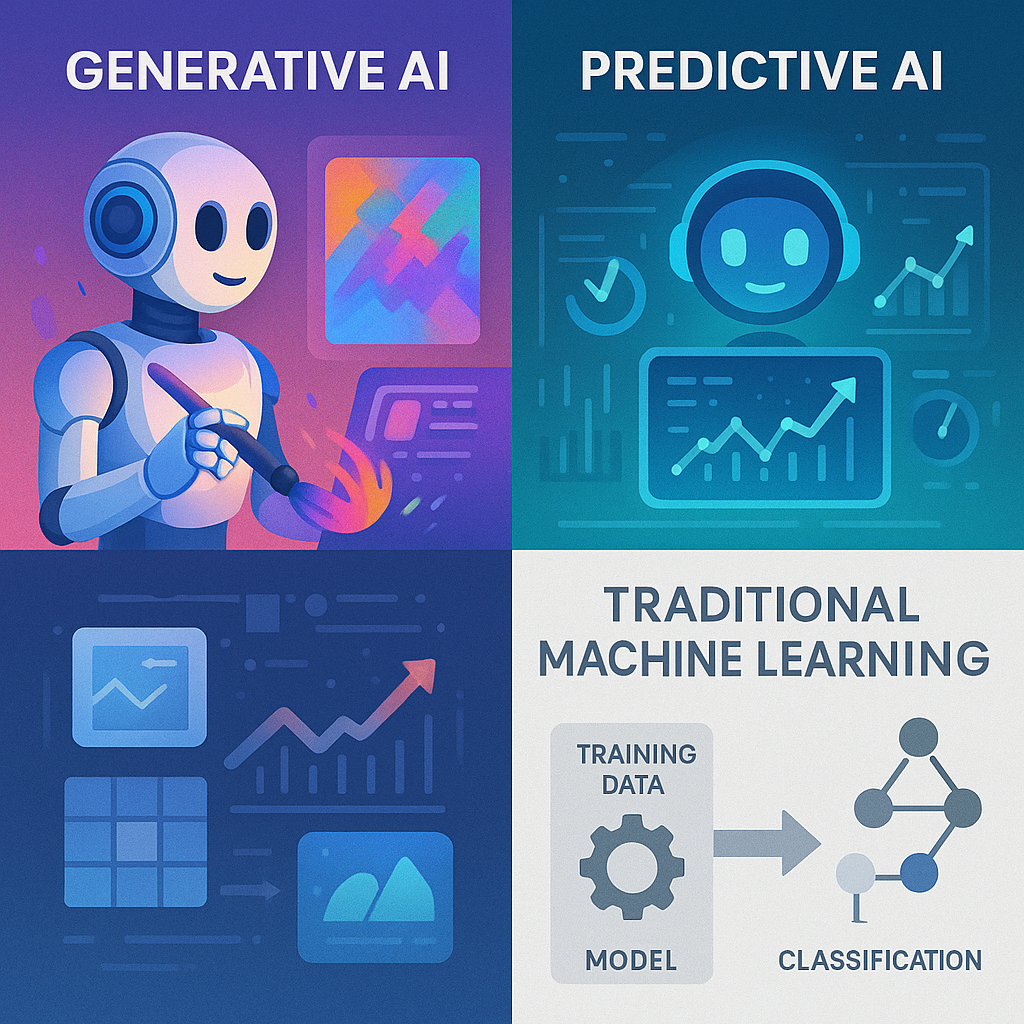AI is booming, and it’s shaking up our work, shopping, learning, and content creation. But have you ever thought about the different AI systems operating behind the curtain? You might’ve come across terms like Generative AI, Predictive AI, and Machine Learning, and wondered how they’re different. Let’s break this down in a simple clear way.
What is Traditional Machine Learning?
Machine Learning (ML) stands as one of the oldest and most used AI types. It gives computers the ability to learn from data and get better over time—similar to how we learn from our experiences.
How It Works:
You feed the machine lots of examples (called data), and it begins to spot patterns. For instance, if you show it images of dogs and cats, it will learn how to distinguish between the two.
Where It’s Used:
- Email spam filters
- Fraud detection
- Voice assistants (like Siri or Alexa)
- Product recommendations
Traditional ML excels at problems that need a clear answer such as “Is this email spam or not?”
What is Predictive AI?
Predictive AI is a type of machine learning that aims to make predictions about the future. It uses past and present data to determine what’s likely to occur next.
How It Works:
Imagine you’re running an online shop. AI that predicts things can look at how your customers shop and guess what they’ll want to buy next. It doesn’t just break down data—it sees what’s coming.
Where It’s Used:
- Guessing sales and stock needs
- Figuring out when customers might leave
- Spotting health risks
- Planning money matters
This type of AI helps businesses think ahead cut down on risks, and make customers happier.
What is Generative AI?
Generative AI is the newest and most exciting type of AI. Unlike old-school ML and models that make predictions, it doesn’t just break down info—it makes new stuff. It can create things like writing, pictures, music, and even videos.
How It Works:
Generative AI gets its training from massive data sets. It figures out what human-made content looks and sounds like—then builds new stuff from the ground up. Take ChatGPT, for instance. It can write articles or answer questions. Other tools like DALL·E can turn words into images.
How People Use It:
- To write blog posts and marketing content
- To create digital artwork
- To develop game characters and worlds
- To make personalized learning experiences
Generative AI has an impact on the creative world by helping humans get more done in less time.
A Quick Comparison
FeatureTraditional MLPredictive AIGenerative AIMain GoalLearn from dataForecast the futureCreate new contentInputLabeled datasetsPast and real-time dataLarge unstructured datasetsOutputClassifications, decisionsPredictionsText, images, videosCommon ToolsScikit-learn, XGBoostForecasting modelsChatGPT, DALL·E, MidJourney
This Matters in the Real World
Various AI types serve different purposes. Businesses and tech learners benefit from knowing which AI to apply. This knowledge can make a significant impact.
- Looking to write product descriptions quickly? Turn to Generative AI.
- Wondering how much inventory to buy? Predictive AI has got you covered.
- Need to sort through loads of documents? Traditional ML can help you out.
Each approach shines in its own way. When applied well, they can speed things up, reduce expenses, and boost efficiency.
